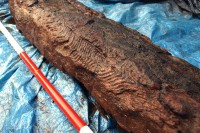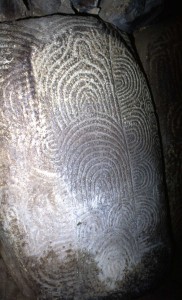 Archaeologists monitoring the construction of a substation at Maerdy Wind Farm in the Rhondda Valley of south Wales last September discovered 12 oak timbers preserved in peat deposits. One of them appeared to have abstract designs of parallel zig-zags and an oval shape carved into it. Ancient timbers, like all organic materials, survive exceptional well in peat thanks to the waterlogged anaerobic environment, but decorative carvings are a far rarer find.
Archaeologists monitoring the construction of a substation at Maerdy Wind Farm in the Rhondda Valley of south Wales last September discovered 12 oak timbers preserved in peat deposits. One of them appeared to have abstract designs of parallel zig-zags and an oval shape carved into it. Ancient timbers, like all organic materials, survive exceptional well in peat thanks to the waterlogged anaerobic environment, but decorative carvings are a far rarer find.
Before they got too excited, the archaeologists sent a sample of the 5’5″ length of timber to be radiocarbon dated. The test returned a date range of 6,000-6,270 years old, the Late Mesolithic/Early Neolithic period in the UK. Most of the artifacts surviving from that period are stone tools, so the discovery of art carved on timber shines a new light on the culture of Late Mesolithic Britain, an important time when people were transitioning from hunter-gatherer nomadic lifestyles to sedentary tribal communities.
They still needed to be sure the designs were deliberate human carvings rather than the freak effect of erosion or some other natural process. The carved timber was sent to the Newport Ship Centre where a 100-foot-long 15th century ship discovered buried in the banks of the River Usk in 2002 is being preserved and examined. They have the facilities to preserve the timber and to 3D laser scan it so the putative carving could be recorded in detail.
With the scans in hand, a team of archaeologists and paleo-entomologists examined the carvings and confirmed that they were not natural features. This conclusion was supported by the lack of any such designs on the other timbers found at the site, all of which are oak and all of which spent thousands of years in the same environment, like a handy ancient wood control group.
“In archaeological circles, this is the is equivalent to winning the lottery,” [Richard Scott Jones, an archaeologist from Heritage Recording Services Wales,] said.
“Finding a piece of decorative art like this is incredibly rare in this area of Wales, especially on uplands. And in terms of timber, this is truly unique. It gives us an idea of the sophistication in terms of artwork around at that time.”
 The only other decorative art of this kind from this era has been found on pottery or carved into standing stones like the passage grave slabs in the Neolithic cairn at Gavrinis in Brittany. Researchers believe it may have been used a boundary marker of tribal property, of a hunting ground or maybe even a sacred site.
The only other decorative art of this kind from this era has been found on pottery or carved into standing stones like the passage grave slabs in the Neolithic cairn at Gavrinis in Brittany. Researchers believe it may have been used a boundary marker of tribal property, of a hunting ground or maybe even a sacred site.
Archaeologists returned to excavate the discovery site in the hopes of finding something associated with the carved timber, perhaps tools used to carve, perhaps more pieces of it, but they didn’t find anything. The took some samples of the environment which are now in the process of being analyzed.
The timber is at the York Archaeological Trust being preserved with polyethylene glycol (PEG). It is also having its tree rings counted so it can be dated more precisely. The PEG treatment should take about a year. Once that’s done some time in 2014, the timber will be moved to the National Museum Cardiff. The eventual plan is for it to go on permanent display at the National History Museum, St Fagans, in the new galleries that are currently being built.